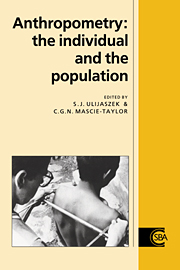Book contents
- Frontmatter
- Contents
- List of contributors
- Preface
- Acknowledgements
- 1 The place of anthropometry in human biology
- 2 Asymmetry and growth
- 3 Intra- and inter-observer error in anthropometric measurement
- 4 Statistical issues in anthropometry
- 5 Statistical constructs of human growth: new growth charts for old
- 6 Growth monitoring and growth cyclicities in developed countries
- 7 Growth monitoring, screening and surveillance in developing countries
- 8 Variability in adult body size: uses in defining the limits of human survival
- 9 Anthropometry and body composition
- 10 Anthropometry and physical performance
- 11 Anthropometry, strength and motor fitness
- 12 Anthropometry in the US armed forces
- Index
2 - Asymmetry and growth
Published online by Cambridge University Press: 19 November 2009
- Frontmatter
- Contents
- List of contributors
- Preface
- Acknowledgements
- 1 The place of anthropometry in human biology
- 2 Asymmetry and growth
- 3 Intra- and inter-observer error in anthropometric measurement
- 4 Statistical issues in anthropometry
- 5 Statistical constructs of human growth: new growth charts for old
- 6 Growth monitoring and growth cyclicities in developed countries
- 7 Growth monitoring, screening and surveillance in developing countries
- 8 Variability in adult body size: uses in defining the limits of human survival
- 9 Anthropometry and body composition
- 10 Anthropometry and physical performance
- 11 Anthropometry, strength and motor fitness
- 12 Anthropometry in the US armed forces
- Index
Summary
Complete body symmetry may be regarded as the norm in the animal kingdom, with a history dating back to the earliest animals to evolve on the planet. In contrast, asymmetry in nature is fairly rare. Examples include the male narwhal with its elongated tusk, formed from a left spiralling overgrown tooth, male fiddler crabs with an enlarged right claw and the New Zealand wrybill, with a beak which bends to the right. Consistent right–left differences within the individual, termed handed asymmetry, are also present in many vertebrates (Brown & Wolpert,1990). Examples of this are the dextral looping of the heart during embryological development, and the variations in the lobes of the lungs between right and left. Minor limb asymmetry, which may be measured using careful anthropometry, is the norm and common in the human. In contrast, gross asymmetry, which is at once detectable by the human eye, is rare.
Limb asymmetry has been described in normal subjects and associated with pathological conditions. It is closely related to laterality (frequently referred to as handedness) and has been shown to be associated with a wide range of musculoskeletal diseases and malignancies. It may also occur spontaneously and have no known pathological cause.
The development of the right and left limbs depends on a similar morphogenesis for the right and left sides of the body and is a consequence of the development of mirror symmetry, the plane of the symmetry being the midline of the embryo. However, this is in contrast to the development of the asymmetrical visceral organs such as the liver, heart and pancreas, which must arise out of the intrinsic handedness within the embryo (Brown et al., 1989).
- Type
- Chapter
- Information
- AnthropometryThe Individual and the Population, pp. 7 - 29Publisher: Cambridge University PressPrint publication year: 1994
- 2
- Cited by



